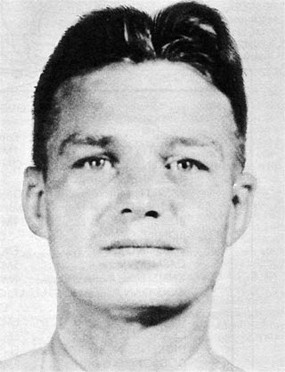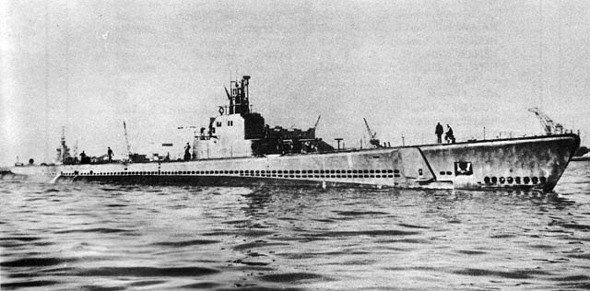
The Navy Department Library
Herring (SS 233)
Herring, under Lieutenant Commander D. Zabriskie, Jr., left Pearl Harbor on 16 May 1944 to conduct her eighth patrol in the Kurile Islands. On 21 May she topped off with fuel at Midway and departed for the Kurile region. No word was received from Herring direct after her departure from Midway, but she did accomplish a rendezvous with Barb on 31 May 1944.
These two boats were to patrol the Kurile Islands area cooperatively, and at the rendezvous, as recorded in Barb's report of her eighth war patrol, the areas for which each was to be responsible were delineated. A few hours after leavingHerring early on the afternoon of 31 May, Barb made contact with two Japanese merchantmen. While developing the contacts Barb heard distant depth charging, which she took as an indication that Herring was making an attack.
Later that evening Barb picked up a prisoner who revealed that Herring had sunk the escort vessel of the convoy Barb had been attacking. The ship sunk was Ishigaki, a new type DE built in 1942, and it was sunk with one torpedo hit. The sinking resulted in the scattering of the three-ship convoy and two ships, which subsequently passed near Barb, were sunk by her. Post-war information reveals that Herring sank the third merchantman of the convoy.
On 3 June 1944 orders were sent to Barb and Herring directing hem to stay outside of a restricted area in which friendly surface ships would be operating during the Marianas Campaign. A receipt was required for this message, but none was heard from Herring. Barb was unable to contact her after 31 May. Consequently on 27 June, Midway was directed to post a sharp lookout forHerring, which might be returning without ability to transmit by radio, and was expected by 3 or 4
--92--
July. When she had not appeared by 13 July 1944, Herring was reported as presumed lost.
Japanese information indicates that Herring was sunk on 1 June 1944, two kilometers south of Point Tagan on Matsuwa Island in the Kuriles. The report states that two merchant ships, Hiburi Maru and Iwaki Maru, were sunk by American torpedoes while at anchor at Matsuwa. In a counterattack, a shore battery scored two direct hits on the conning tower, and "bubbles covered an area about 5 meters wide, and heavy oil covered an area of approximately 15 miles." The position of this attack was around 150 miles from the position where Herring met Barb: the attack occurred on the day after the Barb picked up her prisoner. Barb and Herring were the only U.S. submarines in the area at the time and Barb did not make the attack on the anchored ships referred to above. As a result of the attacks reported by Barb and by the Japanese, Herring has been credited with four ships and 13,202 tons sunk for her last patrol.
For her first seven patrols, Herring sank nine ships, totaling 45,200 tons, and damaged two, totaling an additional 8,400 tons. Her first four patrols were in the Atlantic, the first three off the coast of Spain, and the fourth near Iceland. The first netted an Axis freighter, while on the second Herring saw no enemy ships. Her third patrol saw her sink Nazi U-163 and her fourth was again unproductive of enemy targets. Her fifth patrol was the passage from the United Kingdom, where she had been based for her Atlantic patrols, to New London, Conn., thence to Pearl Harbor. She patrolled the East China Sea on her sixth war run, and sank two large transports, a freighter, and a small escort type vessel. Herring's seventh patrol was in the area just south of the Japanese home islands; here she damaged a destroyer type vessel.
--93--

| U.S.S. Herring (SS-233) | ||||
|---|---|---|---|---|
| Name | Rate | Name | Rate | |
| Anderson, Fred H. Anderson, John L., Jr. Armstrong, James E. Balestrieri, S. Blair, Jack L. Blevins, J.T. Boucher, Leo J. Brennan, James J. Bronder, John J. Brown, Weldson J. Burkett, Timothy Burton, Charles E. Campbell, Nathaniel Carroll, Malcolm D. Carter, Robert A. Chouinard, Robert J. Christopherson, R.W. Compton, John N. Cook, Arnold J. Cunningham, Edward P. Cushion, Henry L. Dawkins, James R. Devenport, Robert E. Edginton, Franklin K. Eitelback, W.J., Jr. *Fleming, Clyde Denton French, George W. Gagnon, Donald R. Gregory, James Leroy Groshens, Charles G. Grote, Clifford H. Guerra, Armand A. Harper, Paul Haskell, Robert G. Hill, Billy G. Hofman, William A. Isbell, Lawrence H. Johnson, John M. Johnson, Laurel K. Johnson, Samuel L., Jr. Kelley, Earl A. Kostal, Michael F., Jr. |
RT2 MoMM2 RM1 ENs S2 S1 S1 TM2 SC2 S2 Ck1 MoMM2 StM2 CMoMM TM3 TM1 TM1 LTJG MoMM2 ENS EM1 MoMM1 TM3 F1 MoMM1 S2 MoMM3 F2 TM3 EM2 RM3 CPhM TM3 MoMM2 S1 LTJG SC3 MoMM2 S2 RM3 EM2 LTJG |
Leahy, Edward L., Jr. Lewis, Warren E. Loftis, Rex H. Mack, Robert L. Mason, Wilbur J. Mayes, John B. McCreary, John W., Jr. McLendon, Willie R. Merriman, Joel A., Jr. Millis, Robert S. Mitchell, Gordon R. Much, Herbert B. Odom, Lester O¹Howell, Harry J. Payne, Robert E. Pepera, Gabriel J. Perkins, James G. Poland, Carl E. Potvin, Omer P. Pressnall, William B. Price, S. Herbert Riley, Charles E. Robbins, Donald L. Rockwell, Emerson E. Ryan, Donald E. Saarm, Andrey H. Schmidt, Charles A. Smiley, W. Kenneth Stern, William Stoneking, Robert R. Sutherland, James A. Swanson, Frederick A. Twigg, Allan W. Van Matre, Van Harlan Vreeland, Le Roy M. Wagoner, George E. Walker, Carmen D. Walsh, John R. Way, Kenneth K. Wilson, Howard R. Wuertele, Elmer C. Zabriski, David, Jr. |
LT TM3 MoMM1 RM3 LT-XO SM3 CQM TM3 SoM2 CEM EM3 F1 F2 CMoMM GM2 FC2 S1 SM3 QM3 ENS EM2 MoMM2 MoMM3 EM1 MoMM3 MoMM3 F1 GM3 S1 SC3 F1 Y2 EM1 EM3 Cox FC3 MoMM2 EM3 S1 TM2 S1 LCDR-CO |
|
Note: *Fleming was mistakenly included on the list in the 1963 edition. He transferred off the boat on 20 May 1944 and survived the war.
--94--





